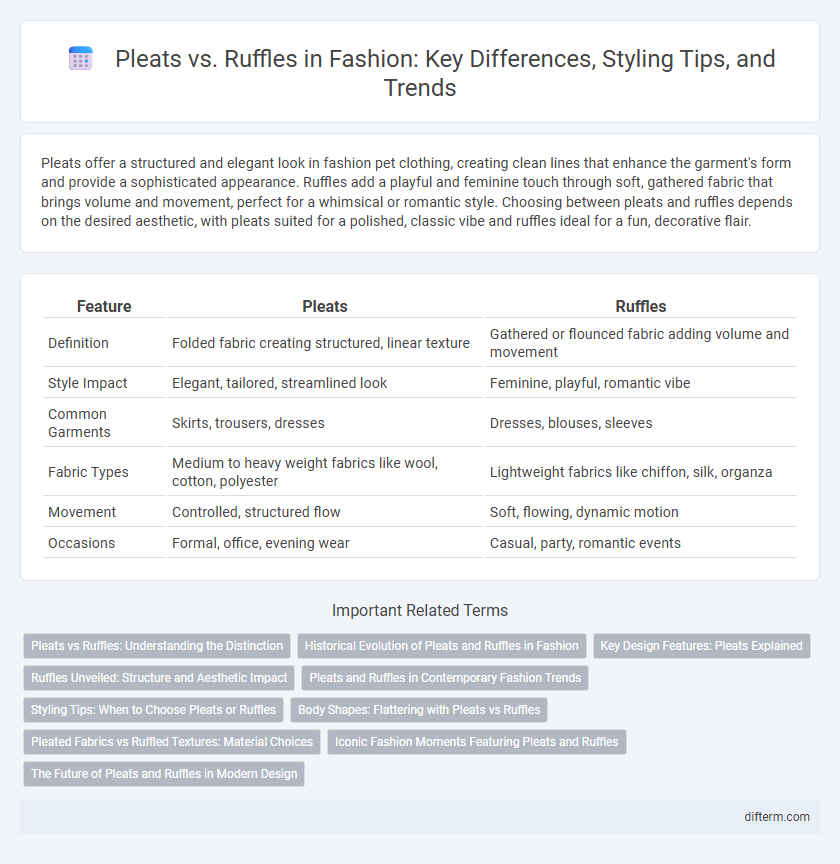Pleats offer a structured and elegant look in fashion pet clothing, creating clean lines that enhance the garment's form and provide a sophisticated appearance. Ruffles add a playful and feminine touch through soft, gathered fabric that brings volume and movement, perfect for a whimsical or romantic style. Choosing between pleats and ruffles depends on the desired aesthetic, with pleats suited for a polished, classic vibe and ruffles ideal for a fun, decorative flair.
Table of Comparison
| Feature | Pleats | Ruffles |
|---|---|---|
| Definition | Folded fabric creating structured, linear texture | Gathered or flounced fabric adding volume and movement |
| Style Impact | Elegant, tailored, streamlined look | Feminine, playful, romantic vibe |
| Common Garments | Skirts, trousers, dresses | Dresses, blouses, sleeves |
| Fabric Types | Medium to heavy weight fabrics like wool, cotton, polyester | Lightweight fabrics like chiffon, silk, organza |
| Movement | Controlled, structured flow | Soft, flowing, dynamic motion |
| Occasions | Formal, office, evening wear | Casual, party, romantic events |
Pleats vs Ruffles: Understanding the Distinction
Pleats create structured, linear folds that add texture and volume to garments, offering a sleek, tailored look favored in skirts, dresses, and blouses. Ruffles consist of gathered fabric strips sewn onto garments, producing soft, cascading waves that emphasize femininity and movement in fashion designs. Understanding the distinction between pleats and ruffles is crucial for designers aiming to balance structure with fluidity in contemporary apparel.
Historical Evolution of Pleats and Ruffles in Fashion
Pleats have a rich history dating back to ancient Egypt, where they were used to create structured and elegant garments, while ruffles emerged prominently in 16th-century Europe as decorative fabric embellishments symbolizing status and femininity. The 19th century saw pleats evolve with innovations like knife pleats and box pleats in tailored clothing, contrasting with the Victorian era's lavish ruffles that added volume and romantic flair to dresses. Modern fashion integrates both elements, with pleats offering sleek, architectural form and ruffles providing dynamic texture, each reflecting centuries of stylistic evolution.
Key Design Features: Pleats Explained
Pleats are precise folds sewn into fabric to create a structured, textured look that enhances volume while maintaining clean lines. Common in skirts and dresses, pleats range from knife and box to accordion styles, each offering unique movement and depth. Their tailored design contrasts with ruffles by providing a more polished and architectural silhouette, making pleats a timeless element in fashion design.
Ruffles Unveiled: Structure and Aesthetic Impact
Ruffles create dynamic texture and movement by layering fabric in soft, gathered waves that accentuate femininity and romanticism in fashion design. Their structured yet playful arrangement enhances volume and depth, making garments visually captivating and ideal for adding dramatic flair without overpowering the overall silhouette. The aesthetic impact of ruffles lies in their versatility, ranging from subtle edge trims to bold statement pieces that transform everyday apparel into visually engaging art.
Pleats and Ruffles in Contemporary Fashion Trends
Pleats dominate contemporary fashion with their structured elegance, offering versatility across skirts, dresses, and trousers while enhancing movement and texture. Ruffles create dynamic volume and femininity, often featured in blouses and eveningwear to add playful or romantic flair. Both elements are essential in modern design, blending classic craftsmanship with innovative styles to elevate seasonal collections.
Styling Tips: When to Choose Pleats or Ruffles
Pleats offer a structured, polished look ideal for professional settings or when aiming for a sleek silhouette, while ruffles add a playful, feminine touch perfect for casual outings or romantic occasions. Choose pleats to create clean lines and emphasize movement without bulk, and opt for ruffles when enhancing volume and texture is desired. Consider fabric type and body shape--lightweight materials complement pleats, whereas flowing fabrics enhance the softness of ruffles.
Body Shapes: Flattering with Pleats vs Ruffles
Pleats create vertical lines that elongate the body, making them ideal for pear-shaped and rectangular figures by enhancing height and slimness. Ruffles add volume and texture, which flatters hourglass and inverted triangle shapes by emphasizing curves and balancing proportions. Choosing pleats or ruffles depends on the desired silhouette enhancement and body shape, optimizing overall fashion harmony.
Pleated Fabrics vs Ruffled Textures: Material Choices
Pleated fabrics often utilize lightweight materials like chiffon, silk, and polyester blends to enhance crisp folds and structured lines, providing a sleek and polished appearance. Ruffled textures typically favor soft, flowing fabrics such as cotton, organza, and lace, which create voluminous, textured layers and a romantic aesthetic. Material choice significantly impacts the garment's silhouette and movement, with pleats offering precision and ruffles delivering dynamic, tactile dimension.
Iconic Fashion Moments Featuring Pleats and Ruffles
Pleats have defined iconic fashion moments such as Princess Diana's elegant pleated skirts in the 1980s, symbolizing timeless sophistication and structure. Ruffles gained prominence in the 1970s with designers like Gucci, adding movement and romantic flair to runway shows and celebrity red carpet appearances. The contrast between structured pleats and voluminous ruffles continues to influence contemporary designers, highlighting pleats' architectural precision versus ruffles' playful texture.
The Future of Pleats and Ruffles in Modern Design
Pleats continue to shape the future of fashion by offering structured elegance and versatility in modern design, often seen in innovative materials that enhance movement and durability. Ruffles evolve as a symbol of playful femininity, integrating asymmetric patterns and mixed textures to create dynamic silhouettes that appeal to contemporary aesthetics. Designers increasingly blend pleats and ruffles, pushing boundaries to redefine traditional elements with a futuristic edge in runway collections worldwide.
Pleats vs Ruffles Infographic

 difterm.com
difterm.com